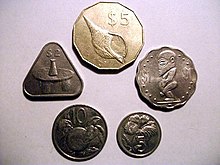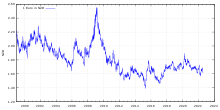New Zealand dollar
| New Zealand dollar | |
|---|---|
| Country: |
|
| Subdivision: | 100 cents |
| ISO 4217 code : | NZD |
| Abbreviation: | NZ $, $ |
|
Exchange rate : (August 24, 2020) |
1 EUR = 1.806 NZD 1 CHF = 1.678 NZD |
The New Zealand dollar ( English New Zealand dollar , German also New Zealand dollar ) is the currency of New Zealand . It is also the currency in the New Zealand colony of Tokelau and Niue , which is in free association with New Zealand, and the Pitcairn Islands .
A New Zealand dollar is divided into 100 cents, the ISO code is NZD and the most common abbreviation is NZ $. Colloquially, the New Zealand dollar is also called kiwi (dollar) because the word kiwi is usually associated with New Zealand and a kiwi is depicted on the 1 dollar coin.
On specially issued for Tokelau Commemorative Coin is occasionally tokelauische name Tala to find.
history
On July 10, 1967, the New Zealand pound , which was divided into 20 shillings , was replaced by the New Zealand dollar (NZ $) at the rate of 1 pound = 2 NZ $ (with one dollar divided into 100 cents). The 10-cent coin also bore the value “One Shilling”, which was not used in the minting from 1970.
Coins and banknotes
Coins
- Images approximately on the same scale
| Face value | image | motive | material | Weight | diameter | thickness |
|---|---|---|---|---|---|---|
| 10 cents | A carved Māori head | Steel with a copper coating | 3.30 g | 20.50 mm | 1.58 mm | |
| 20 cents | Pukaki, a Māori chief | Nickel-plated steel | 4.00 g | 21.75 mm | 1.56 mm | |
| 50 cents | Endeavor and Mount Taranaki | Nickel-plated steel | 5.00 g | 24.75 mm | 1.70; mm | |
| 1 dollar | Kiwi and silver fern | Aluminum bronze | 8.00 g | 23.00 mm | 2.74 mm | |
| 2 dollars |

|
Great Egret | Aluminum bronze | 10.00 g | 26.50 mm | 2.70 mm |
Old coins
| These coins (1 cent and 2 cents) were approved as official tender until April 30, 1990: | |

|
The 1 cent coin showed a frond of the silver fern , one of the national emblems of New Zealand. |

|
The 2 cent coin showed a branch of the Kōwhai , one of the national emblems of New Zealand. |
|
These coins were accepted as official tender until October 31, 2006 : |
|

|
The 5 cent coin depicted a bridge lizard , the last surviving species of an otherwise extinct family of reptiles. This coin was 19.43 mm in diameter. |
| The 10 cent coin showed a carved head of the Māori . This coin was 23.62 mm in diameter. | |
| This 20 cent coin showed a kiwi. | |
| This 20 cent coin showed a Maori carving by Chief Pukaki . These coins were 28.58 mm in diameter. | |

|
The 50 cent coin showed the Endeavor , the ship of Captain James Cook . With a diameter of 31.75 mm, this coin was one of the largest coins in circulation worldwide (for comparison: the Swiss five-franc coin has a diameter of 31.45 mm). |
Banknotes
There are currently two series of banknotes in circulation in New Zealand , $ 5, $ 10, $ 20, $ 50 and $ 100, Series 6 and Series 7.
New Zealand dollar (6th series)
At the turn of the millennium, the 6th series of banknotes was put into circulation. This shows essentially the same picture as the previous 5th series, but the banknotes - as in many countries in the Pacific region - are printed on polymer .
| Face value | Motif front | Motif back |
|---|---|---|
| 5 dollars | Sir Edmund Hillary | Yellow-eyed penguin |
| 10 dollars | Kate Sheppard | Duck-billed duck |
| 20 dollars | Elizabeth II | Maori falcon |
| 50 dollars | Sir Apirana Ngata | Ragged crow |
| 100 dollars | Sir Ernest Rutherford | Yellow-headed |
New Zealand dollar (7th series)
On November 20, 2014, the Reserve Bank of New Zealand released a video introducing the seventh series of banknotes. The series with the working title Brighter Money had a stronger color scheme, improved security features and the integration of the Maori language .
The design came from the Canadian Bank Note Company , which also printed the polypropylene banknotes . The 5 and 10 New Zealand dollar banknotes were put into circulation by the central bank on October 1, 2015, with the 20, 50 and 100 dollar notes following in April 2016.
Cook Islands dollar
In the Cook Islands , the Cook Islands dollar, which is equivalent to the New Zealand dollar in terms of value, is used as separate cash. The first series of banknotes of $ 3, $ 10, and $ 20 shows a woman riding a shark. The second series consists of the values 3, 10, 20 and 50 dollars. Dividing coins come in values of 1, 2, 5, 10, 20 and 50 cents as well as 1, 2 and 5 dollars.
The Cook Islands also issue coin bars and coin tables.
Pitcairn Islands dollars
The Pitcairn Islands have been issuing commemorative coins since 1988 and currency coins in their own currency, linked to the New Zealand dollar, since 2009.
The lack of the 1, 2 and 5 cent coins
Before April 30, 1990, 1 and 2 cent coins were also legal tender, but were then withdrawn. Since November 1, 2006, no more 5-cent coins have been issued. This does not cause any problems with cashless payment transactions . Since July 31, 2006, cash payments have to be rounded to the nearest 10 cents . Some larger department store chains always round off, while other retailers round their prices to 10 cents from the start.
Plastic banknotes
The banknotes have been made from polypropylene since 1999 . Until then, they were made of cotton .
Exchange of coins
New coins were introduced on July 31, 2006. The rising cost of materials and their size spoke against the old coins. At 3.2 centimeters, the 50 cent coin was one of the largest coins in circulation worldwide. The size of the 10 cent coin was too similar to that of the 1 dollar coin. The 5-cent coins were withdrawn from circulation.
The new coins show the same motifs as the old coins, but are significantly smaller. The new 10-cent coin is copper-colored, the 20-cent coin has a Spanish flower as knurling on.
value
The value of a New Zealand dollar was between EUR 0.45 and EUR 0.55 in 2003 and 2004, and at the end of 2005 it reached a high of around EUR 0.61. After plummeting in the first half of 2006 with a low of around EUR 0.47 in July 2006, the New Zealand dollar initially recovered, but then slipped to EUR 0.37 by February 2009. Since then it has been steadily approaching the EUR 0.60 mark again.
Web links
- Official website of the Reserve Bank of New Zealand (English)
- New Zealand Trading Banks - Private web server with descriptions and images of New Zealand banknotes from 1840–1933 (English)
- New Zealand banknotes ( German ) ( English )
Individual evidence
- ↑ Banknotes in circulation . Reserve Bank of New Zealand , accessed July 31, 2017 .
- ↑ New Zealand is upgrading its banknotes . Reserve Bank of New Zealand , accessed September 8, 2015 (web animation explaining the new banknotes and when they will appear).
- ↑ Highlights from the launch of the new banknote design - 2014 . In: Youtube. Reserve Bank of New Zealand , November 25, 2014, accessed July 31, 2017 (video of the press conference and presentation of the new banknotes).
- ^ Banknote Gallery - Banknotes from Cook Islands . RealBanknotes.com , accessed August 28, 2016 .
- ^ An Ordinance Relating to Currency. Laws of Pitcairn, Henderson, Ducie and Oeno Islands, June 23, 1988.


